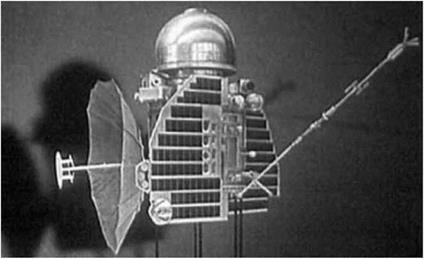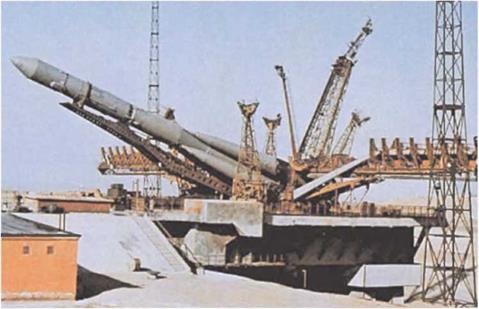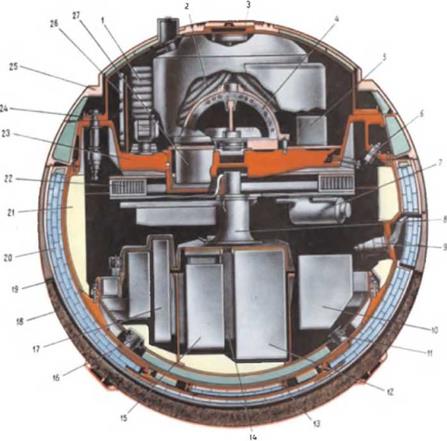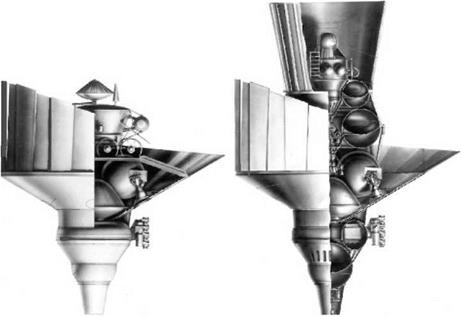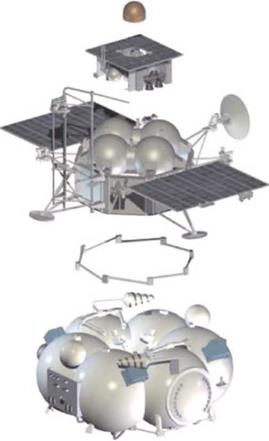Campaign objectives:
In planning of their 1973 campaign for Mars the Soviets were aware of the IJS plan to send orbiter/landers to the planet in 1975. They also knew that these Vikings were considerably more capable than their own 1971 lander. Adding to this problem, the 1973 opportunity required more energy than that of 1971 and they could not repeat the M-71 orbiter /lander strategy. If they were to send landers to Mars in 1973. then the carrier spacecraft would have to fly past the planet. Their spacecraft were too massive and the Proton-K launcher did not have enough capability to combine an orbiter and a lander in 1973. Chagrined by the poor performance of their spacecraft in 1971 in comparison to the success of the Mariner 9 orbiter, yet encouraged by the near-success of the Mars 3 lander, the Soviets w ere determined to score a success at Mars ahead of the Viking missions. In fact the US had hoped to launch these in 1973 but financial problems forced a postponement to 1975. Knowing there would be no American competition in 1973, the Soviets decided upon four launches to send an armada consisting of two or biters and two flyby landers. The or biters would be sent first so that they could act as communications relays for the landers on the surface. After releasing its lander, a carrier spacecraft would relay telemetry from the entry system to Earth in real-time during the entry and descent, and then perform its own remote-sensing observations of the planet in making its flyby.
|
Spacecraft launched
|
|
|
First spacecraft:
|
Mars 4 (M-73 No.52S)
|
|
Mission Type:
|
Mars Orbiter
|
|
Country! Builder:
|
USSR/NPO-Lavoclikin
|
|
Launch Vehicle:
|
Proton-K
|
|
Launch Date ‘: і ime:
|
July 21, 1973 at 19:30:59 IJT (Baikonur)
|
|
Em ounter Da te l Time:
|
February 10, 1974
|
|
Out come:
|
Failed orbit inserted burn, flew past planet.
|
|
Second spacecraft:
|
Mars 5 (M-73 No.53S)
|
|
Mission Type:
|
Mars Orbit er
|
|
Country і Builder::
|
USSR/NPO-Lavochkin
|
|
Launch Vehicle:
|
Proton-K
|
|
Launch Date; Time:
|
July 25, 1973 at 18:55:48 UT (Baikonur)
|
|
Encounter Date/ Time:
|
February 12, 1974
|
|
Mission End:
|
February 28, 1974
|
|
Outcome:
|
Successful, but short-lived.
|
|
Third spacecraft:
|
Mars 6 (M-73 No.50P)
|
|
Mission Type:
|
Mars Flyby,’Lander
|
|
Country I Builder:
|
USSR/NPO-Lavochkin
|
|
Launch Vehicle:
|
Proton-K
|
|
Launch Date! 7 ime:
|
August 5. 1973 at 17:45:48 UT (Baikonur)
|
|
Enc ounter Da tel Time:
|
March 12, 1974
|
|
Outcome:
|
Successful descent, but lander lost at touchdown.
|
|
Fourth spacecraft:
|
Mars 7 (M-73 No.5IP)
|
|
Mission Type:
|
Mars Flyby.’Lander
|
|
Country і Builder:
|
USSR/NPO-Lavochkin
|
|
Launch Vehicle:
|
Proton-K
|
|
Launch Date: Time:
|
August 9, 1973 at 17:00:17 UT (Baikonur)
|
|
Encounter Date/7 ime:
|
March 9, 1974
|
|
Outcome:
|
Entry system failed. Hew past Mars.
|
By 1973 the US and USSR were in a period of detente, and cooperation between the two space programs had increased with a number of joint working groups and a joint Apollo-Sovuz mission scheduled for 1975. The Soviets gave the US the data from Mars 2 and 3 and from Venera 8 in return for an accurate ephemeris for Mars, models of its atmosphere, and Mariner 9 orbital imagery of the zones chosen for the Mars 6 and 7 landers.
In order to save cost and reduce risk, Soviet engineers used the same spacecraft as in 1971 with minimum changes. But they were plagued with electronics problems in test and in flight. One crucial difference between the 1971 electronics packages and those built for 1973 were that gold leads had been replaced with aluminum on a key transistor used throughout the spacecraft. This difference was discovered very late in the integration and test program, wiien some of the new 2T-312 transistors suffered failures. The difficulties with the 2T-312 transistor were to be the Achilles’ heel of the 1973 campaign. They were in almost every engineering subsystem and science instrument on the spacecraft. Tests showed that these transistors generally failed 1.5 to 2 years after production. This would correspond to Mars arrival, and they could not all be replaced in time to meet the launch window. An analysis estimated a 50% likelihood of a complete mission failure owing to these transistors. In a US program this would have mandated postponing the mission, but the Soviet decision makers, in their rush to beat the Amerieans to the surface of Mars, dismissed the concerns of the engineers and opted to take the risk and launch with the suspect transistors.
The problem of the transistors became manifest almost immediately after launch, and plagued the entire campaign. All four spacecraft reached Mars but with three in a seriously crippled state. One orbiter flew past the planet, one lander missed and the other lander was lost just before touchdown after returning a degraded set of descent data. Mars 5 was able to achieve orbit, but then failed after less than a month.
The paucity of data from this flotilla compared to the mass of data returned from the single long-lived Mariner 9 orbiter, considered together with the lack of a viable competitor to the forthcoming Viking missions, led the Soviets to abandon Mars in favor of Venus for the foreseeable future – and it would be 15 years before they tried again.
Spacecraft:
The overall design and subsystems of the spacecraft for the 1973 Mars campaign were the same as before, although the scientific instruments were slightly different. The most signifieam engineering difference was the installation of a new telemetry system solely to enable the flyby carrier to relay data from its entry system to Earth in real-time; this would prove crucial in the ease of Mars 6. The landers telemetry system remained the same and communications from the surface would be through the or biters.
The M-73 orbiters were almost identical to the M-71S spacecraft. Their function was to enter into orbit around Mars, communicate with the landers, and obtain their own information on the composition, structure, and properties of the atmosphere and surface of the planet. The science payload was mounted on top of the spacecraft, in the same place as the entry systems of the flyby spacecraft. The principal function of the flyby carrier was to release the entry system on a proper entry trajectory and provide a real-time telemetry relay during the descent. It had science instruments for cruise and Mars flyby observations. Because the Mars 3 lander had made it to the surface, the entry systems were the same. However, the science payload of the landers was upgraded.
Mars 4 and 5 launch mass: 3,440 kg (orbiter; dry mass 2,270 kg)
Mars 6 and 7 launch mass: 3,260 kg (flyby vehicle)
1,210 kg (entry vehicle)
635 kg (lander system on descent)
358 kg (lander)
4,470 kg (total)
|
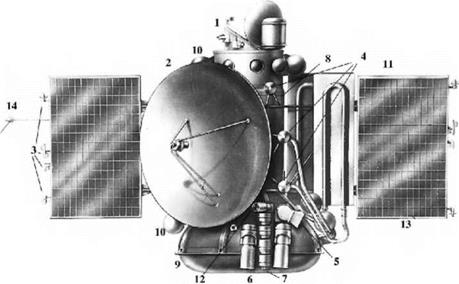
Figure 13.5 Mars 4 and Mars 5 spacecraft diagram: 1. Science instrument compartment; 2. Parabolic high-gain antenna; 3. Attitude control system; 4. Spiral antennas; 5. Mars sensor; 6. Star sensor; 7. Sun sensor; 8. Fuel tank and propulsion system; 9. Avionics compartment; 10. Attitude control gas tanks; 11. Thermal control radiators; 12. Earth sensor; 13. Solar panels; 14. Magnetometer.
|
|
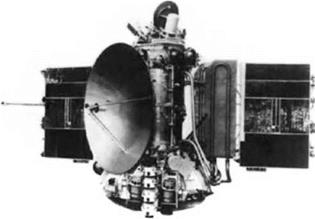
Figure 13.6 Mars 4 and Mars 5.
|
|

Figure 13.7 Mars 6 and Mars 7 spacecraft diagram (from Space Travel Encyclopedia): 1. Lander; 2. Parabolic antenna; 3. Attitude control gas jets; 4. Spiral antenna; 5. Mars sensor; 6. Star sensor; 7. Sun sensor; 8. Propulsion system; 9. Instrument compartment; 10. Attitude control gas tanks; 11. Radiators; 12. Earth sensor; 13. Solar panels; 14. ‘STEREO’ radio emission antennae.
|
|

Figure 13.8 Mars 6 and Mars 7,
|
|

Figure 13.9 Mars 6 entry system in test.
|
Payloads:
Some of the M-73 scientific instruments were redesigned forms of those carried by Mars 2 and 3, but others were new. The Mars 4 and 5 orbiters and the Mars 6 and 7 flyby spacecraft were equipped as follows:
1. FTU facsimile imaging system
2. Optical-mechanical panoramic imaging system
3. Infrared radiometer (8 to 40 microns) for measurement of surface temperature (Mars 5 only)
4. Infrared photometer in five carbon dioxide bands around 2 microns to obtain surface altitude profiles
5. Microwave polarimeter (3.5 cm) for measurement of dielectric constant and subsurface temperatures
6. Two polarimeters in ten bands from 0.32 to 0.70 microns to characterize surface texture (French-Soviet)
7. Four band visible photometer in range 0.37 to 0.6 microns for measurement of color and albedo of the surface and atmosphere (Mars 5 only)
8. Infrared narrow-band 1.38 micron photometer for measurement of water vapor content in the atmosphere
9. Ultraviolet photometer (0.260 and 0.280 microns) for measurement of ozone
10. Scanning photometer (0.3 to 0.9 microns) to study emissions in the upper atmosphere (Mars 5 only)
11. Gamma-ray spectrometer for surface elemental composition
12. Micrometeoroid sensors (Mars 6 and 7 only)
13. Lyman-alpha photometer for measurement of upper atmosphere hydrogen (French-Soviet)
14. Solar wind plasma sensors (8) for measurement of speed, temperature and composition in the 30 eV to 10 keV energy range (Mars 4 and 7 only)
15. Boom mounted three-axis lluxgate magnetometer (Mars 4 and 7 only)
16. STHRHO-2 to study solar radio emissions (French-Soviet. Mars 7 only)
17. ZIIEMO to study solar protons and electrons (French-Soviet, Mars 6 and 7 only)
18. Multichannel electrostatic analy/cr (Mars 4 and 5 only)
19. Dual-frequency radio occultation experiment to profile ionospheric electrons and tropospheric density.
Two types of imaging system were employed. The first was a version of the M-71 FTU camera with various technical improvements and more film and faster scanning rates. The second was a single line push-broom panoramic imager that was to scan a 30 degree field of view from horizon to horizon and was sensitive in both the visible and near-infra red. It stored its data on a 90 minute analog tape recorder for replay to Earth.
The FTLT optics were as before: two bore-sighted cameras, one an f/2.8 lens with a focal length of 52 mm and a 35.7 degree field of view, and the other an 174.5 lens with a 350 mm focal length and a 5.67 degree field of view. They each weighed about 9 kg. The wide angle camera was equipped with red. green, blue and orange filters, and the narrow angle one used an orange long-pass filter. Twenty meters of 25.4 mm film was contained in a radiation-shielded magazine. This was sufficient for at most 480 frames. Exposure times alternated between 1 50th and 1/150th of a second. Each camera produced a 23 x 22.5 mm frame and the film could be scanned at up to ten resolutions, only three of which were used actually: 235 x 220,940 x 800, and 1.880 x 1,760 pixels. The scanned images were transmitted at either 512 or 1.024 pixels per second by the dedicated impulse transmitter. At the intended operating altitude these cameras would provide resolutions of between 100 and 1,000 meters.
The push-broom panoramic camera system was first used by Luna 19 in 1971. It comprised two optical-mechanical cameras, each with a single photomultiplier tube and a rotating prism to scan a 30 degree field of view aeross the spacecraft’s track. One camera had red and orange filters and was sensitive across the visible spectrum and the other used a red long-pass filter with a photomultiplier that was sensitive in the infrared. They scanned at 4 lines/seeond and produced 250 cycles line for video recording on magnetic tape at 1,000 IIz. The readout rate was 1 line/second and the transmission was commanded at 256 or 512 pixels line resolution.
The payload of the entry system and lander w as essentially the same as flown on Mars 2 and 3, but with upgraded imagers, mass spectrometer, and temperature and pressure sensors. The Doppler experimeni to measure winds during the descent was new. Most significantly, it was nowr possible to transmit the descent data in real-time rather than storing it for transmission after landing. They were equipped as follow s:
1. Accelerometer for atmospheric density during entry
2. Doppler experiment for winds and turbulence on descent
3. Temperature and pressure sensors on descent and landing
4. Radio altimeter for providing altitudes on descent
5. Mass spectrometer for atmospheric composition on descent and landing
6. Atmospheric density and wind velocity on the surface
7. Two panoramic television cameras for stereo viewing of the surface
8. Gamma-ray spectrometer for soil composition mounted in a petal
9. X-ray spectrometer for soil composition deployed to the surface from a petal
10. PrOP-M walking robot deployed to the surface from this same petal with
onboard gamma-ray densitometer and conical penetrometer.
Doppler measurements and the radio altimeter, accelerometer, temperature, and pressure sensors operated from the beginning of parachute deployment right down to the surface.
Mission descriptions:
All four spacecraft were dispatched successfully but predictably and inevitably first Mars 6, then Mars 7, then Mars 4 suffered system-wide failures within a matter of weeks owing to the faulty transistor. Only Mars 5 arrived relatively trouble free and was able to enter orbit around Mars, but it suffered a pressure leak and shortly thereafter fell silent.
Mars 4:
Mars 4 was launched on July 21, 1973. It made a midcourse correction on July 30, but the computer developed problems that prevented a second midcourse correction. It reached the planet on February 10, 1974, but the engine failed to ignite for the orbit insertion maneuver and the spacecraft flew? past the planet at a range of 1,844 km.
Mars 5:
Mars 5 was launched on July 25, 1973. It made midcoursc corrections on August 3 and on February 2, 1974, and followed through with the orbit insertion maneuver at 15:44:25 UT on February 12 to achieve a 1,760 km x 32,585 km orbit with a period of 24.88 hours inclined at 35.3 degrees to the equator. Some unknown event during orbit insertion triggered a slow leak in the instrument compartment. An accelerated plan of observations w as prepared that focused on obtaining high resolution imagery of the surface. But when the pressure fell below operating levels in the transmitter housing on February 28 after only 22 orbits, this prematurely ended the mission and ruled out the use of this spacecraft as a relay for the landers that were scheduled to arrive in early March.
Mars 6:
Mars 6 was launched on August 4, 1973, and conducted a midcourse correction on August 13. At the end of September the science and operations dow nlink was lost, almost certainly due to the failure of a 21-312 transistor. Only two channels in the telemetry system remained operational, neither of which provided any information on spacecraft status. Refusing to give up, the engineers continued to send commands to the spacecraft in the hope that the receivers might still be functioning. As it turned out the command uplink was unaffected, and Mars 6 dutifully obeyed the commands and executed its autonomous functions. Unable to report to Earth, in February 1974 it autonomously determined its position, calculated the second midcourse correction and carried this out. Upon approaching the planet on March 12, it properly executed the optical navigation and targeting, and then released its entry system at a range of
48,0 km from the planet with just 3 hours remaining to atmospheric entry.
Ground controllers first realized that Mars 6 had done its job shortly thereafter, at 08:39.07 UT, when data began to arrive through the dedicated relay channel. At that time the entry system was 4.800 km from its target. The spacecraft was able to relay data throughout entry and descent, and then continued past the planet, passing within 1,600 km of the surface. This performance was a monumental achievement in spacecraft autonomy for the Soviet program so early in the history of planetary exploration.
The entry system penetrated the atmosphere at 09:05:53 UT at a speed of 5.6 km/s and an 11.7 degree angle of attack. Loss of signal due to plasma effects occurred at 09:06:20 at an altitude of 75 km. The signal was regained at 09:07:20 at 29 km. with the start of the data transmission. The main parachute was deployed at 09:08:32 after the entry system had slowed to 600 m/s at an altitude of 20 km. The canopy opened fully at 09:08:44. and the capsule started to transmit data on altitudes, temperatures and pressures. The mass spectrometry was stored for transmission after the landing. The Doppler shifts on the signal were noted. The capsule appeared to be swaying under the parachute more than expected, impairing the transmission quality. Ignition of the rocket engines was confirmed but the transmission cut off at 09:11:05 when the lander was "in direct proximity to the surface’*, probably when it hit the surface. The velocity at the time of signal loss was 61 m/s, which was excessive for a safe touchdown. The transmitter was programmed to turn off after the lander had been released in order to switch over to a different set of VHF antennas on the lander. No further signals were received. The fate of the lander is unknown. It lies at 23.90 S 19.42 W in the Margaritifer Sinus region, in the vicinity of Samara Valley, where the landscape is characterized by steep slopes.
Mars 7:
Mars 7 was launched 4 days after Mars 6 but flew a faster trajectory which arrived at the planet 3 days earlier. It made only one course correction on August 16, 1973. An early failure in the communications system cost it one transmitter, but it was able to remain in contact. At Mars the targeting maneuvers to set up the entry system were executed properly and the entry system was released on March 9. 1974. However, most likely owing to a failed 2T-312 transistor, the entry system computer did not issue the command to fire the retro-rocket, with the result that it missed the planet by 1,300 km. The intended target was in the crater Galle at 51.2 S 30.9 W. The carrier spacecraft provided some data during its flyby.
Results:
Orbiters:
Imagery
After Mars 4 failed to execute its orbit insertion maneuver it flew past the planet and continued to return interplanetary data from solar orbit. During the flyby it returned one swath of twelve pictures and two panoramas in a 6 minute imaging cycle from a range of 1,900 to 2Л 00 km. Two dual-frequency radio occultation profiles were also obtained, one on passing behind the planet as viewed from Earth and the other upon exiting and these supplied the first indication of a night-side ionosphere.
The Mars 5 orbiter operated for only 25 days after orbit insertion, and returned atmospheric data and images of a small portion of the southern hemisphere of Mars. In all it returned 108 pictures, but the narrow angle ones were motion blurred. The useful data included 43 wide angle images and five panoramas which were returned in five imaging sessions over a 9 day period, all of roughly the same area, which was near the imaging track of Mariner 6 and showed swaths of the area south of Valles Marineris from 5 N 330 W to 20 S 130"W. Measurements by other remote sensing instruments were also made near periapsis along seven adjacent arcs in this region. High cirrus clouds and yellow clouds of fine dust w ere identified.
Surface properties
Data returned from orbit by the infrared radiometer on Mars 5 showed a maximum surface temperature of-Г C, -43 C near the terminator, and -73°C at night. It gave a thermal inertia for the soil that was consistent with grains 0.1 to 0.5 mm in size, and polarization data in the visible spectrum implied grain sizes smaller than 0.04 mm in aeolian deposits of variable cover. The polarization at 3.5 cm suggested a dielectric constant of 2.5 to 4 at depths of several tens of cm. The oxygen, silicon, aluminum, iron, uranium, thorium, and potassium sensed by the gamma-ray spectrometer from orbit suggested a surface similar to terrestrial mafic rocks.
Lo wer atmosphere
Six altitude profiles were measured by the carbon dioxide photometer along a path between 20 and 120 :W in longitude and spanning 20 to 40r’S in latitude, and these were in general agreement with the Mariner 9 ultraviolet spectrometer data. Surface pressures as high as 6.7 millibars were determined. Mars 3 had found only 10 to 20 precipitable microns of water vapor while the dust storm was raging in 1971. Two years later. M ars 5 found abundances as high as 100 precipitable microns south of the Tharsis region. The water vapor content was variable by a factor of 4 to 5 across the planet. An ozone layer about 7 km thick was detected at 40 km altitude in the equatorial region, not near the surface as anticipated, with a concentration of about 1/1,000th that of Earth’s ozone layer. The Mariners were able to detect ozone only at the poles where it is more abundant. The existence of argon in the atmosphere was confirmed.
|
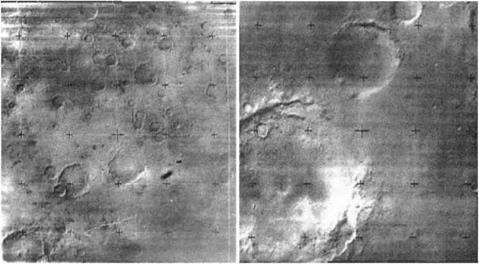
Figure 13.10 Pictures from Mars 4 during its flyby and from Mars 5 once it was in orbit. Left: cratered terrain at 35.5eS 14.5’W taken hv Mars 4 from 1,800 km range through a red filter. From lower left the large craters are Lohse, Hartwig and Vogel. Right: the crater Lampland at Зб^ 79"W taken by Mars 5 from 1,700 km range.
|
|

Figure 13.12 Picture from the Mars 5 panoramic imager (processing by Ted Stryk).
|
Upper atmosphere and ionosphere
The Lyman-alpha instrument found the exosphere temperature to be 295 to 355K. with the temperatures in the altitude range 87 to 200 km being 10 degrees lower. No upper atmosphere emissions were noted by the visible spectrometer in the range 0.3 to 0.8 microns. Mars 5 also performed a radio occulta lion experiment on one orbit and its results, with those from the flyby occupation measurements for Mars 4 and 6. showed the existence of a night-side ionosphere with a maximum electron density of 4,600/cc at an altitude of 110 km, and an atmospheric pressure near the surface of 6.7 millibars.
The fields and particles instruments returned a significant data set to complement the M-71 orbiter data. Two distinct plasma zones were found inside the bow shock between the undisturbed solar wind and the planetary magnetosphere: a thermalized plasma behind the bow shock, and a small electrical current carried by protons in the magnetotail. The bow shock was held at an altitude of 350 km. The plasma results and magnetometer measurements were consistent with the planet having an intrinsic magnetic field of about 0.0003 times the strength of Earth’s field, and inclined 15 or 20 degrees from the rotational axis which, as in the case of Earth, is tilted 23 degrees from the perpendicular to the plane of its orbit.
Flyby spacecraft:
The radio occupation made by the Mars 6 carrier spacecraft verified the detection by Mars 4 and 5 of a night-side ionosphere. The French STEREO instrument on Mars 7 w orked satisfactorily throughout the cruise to Mars but the spacecraft did not return any useful science during the flyby. It was the last of the armada to fall silent, wiiieh it did in September 1974.
Entry systems:
The Mars 6 entry system transmitted for 224 seconds during its descent before it fell silent, providing the first in-situ measurements of this atmosphere. Although a lot of it was unreadable due to the degradation of another 2T-312 transistor, enough data w’as obtained to profile the temperature and pressure from an altitude of about 29 km down to the surface. The density of the atmosphere from 82 km down to this level was inferred from accelerometer data. Winds of 12 to 15 m s were measured from an altitude of 7 km dowm to near the surface. A surface pressure of 6.1 millibars and a temperature of -28 C were derived from temperature, pressure, accelerometer and Doppler data. The surface winds were 8 to 12m/s. Other parameters included a lapse rate of 2.5K/km, the presence of the tropopause at an altitude of 25 to 30 km. and an almost isothermal stratosphere at a temperature of 150 to 160K. These values were consistent with measurements by the Mars 5 orbiter, and were later confirmed by the Viking missions. Instruments also indicated "several times" more atmospheric water vapor than previously reported. The mass spectrometer data were stored during the descent for transmission after landing, and so were lost. However, the current to the vacuum pump was transmitted during the descent as an engineering parameter, and a sleep increase in current was interpreted as an indication of argon at an abundance of 25 to 45%. which was implausibly large; the actual value was found by the Vikings to be a more reasonable 1.6%.
Landers:
Ко transmissions were ever received from the Mars 6 lander and no results w’ere obtained from the surface. The Mars 7 entry system missed the planet entirely.











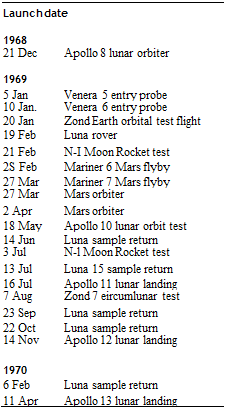







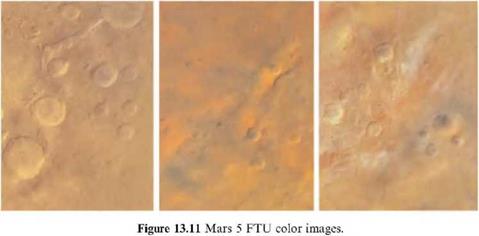


 Korolev, Sergey Pavlovich 1907-1966
Korolev, Sergey Pavlovich 1907-1966


